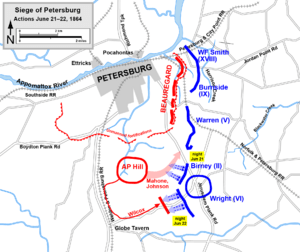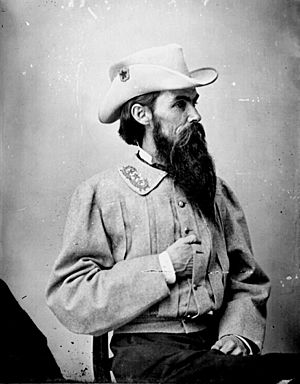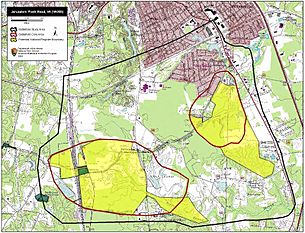Battle of Jerusalem Plank Road facts for kids
Quick facts for kids Battle of Jerusalem Plank Road |
|||||||
|---|---|---|---|---|---|---|---|
| Part of the American Civil War | |||||||
|
|||||||
| Belligerents | |||||||
| Commanders and leaders | |||||||
| David B. Birney Horatio G. Wright |
A. P. Hill William Mahone |
||||||
| Units involved | |||||||
| II Corps VI Corps |
Third Corps | ||||||
| Strength | |||||||
| 27,000 | 8,000 | ||||||
| Casualties and losses | |||||||
| 2,962 | 572 | ||||||
The Battle of Jerusalem Plank Road was an important fight during the American Civil War. It happened from June 21 to 23, 1864, near Petersburg, Virginia. This battle was also known as the First Battle of the Weldon Railroad.
It was one of the first attempts by the Union to cut off supplies to Petersburg. The Union wanted to stretch their battle lines further west. Two Union army groups tried to cut the railroad tracks that brought supplies. However, soldiers from the Confederate Army of Northern Virginia attacked them. General William Mahone's division led this attack. The battle ended without a clear winner. The Weldon Railroad stayed under Confederate control for a while. But the Union Army did start to extend its defenses, putting more pressure on the city.
Contents
Why Did the Battle of Jerusalem Plank Road Happen?
After failing to capture Petersburg in earlier attacks, Union General Ulysses S. Grant decided to surround the city. This is called a siege. Petersburg was defended by Confederate General Robert E. Lee's army. The Union Army, led by General George Meade, dug in east of the city. Their lines ran from Jerusalem Plank Road to the Appomattox River.
Grant's main goal was to control the three railroad lines that supplied Petersburg and the Confederate capital, Richmond. These were the Richmond and Petersburg Railroad, the South Side Railroad, and the Petersburg and Weldon Railroad. The Petersburg and Weldon Railroad was very important. It connected to Wilmington, North Carolina, which was the Confederacy's last major port.
Grant planned a large cavalry raid to destroy the South Side and Weldon railroads further away. But he also wanted a big group of infantry (foot soldiers) to attack the Weldon Railroad closer to his position. General Meade chose the II Corps and the VI Corps for this mission. The II Corps was temporarily led by General David B. Birney. The VI Corps was led by General Horatio G. Wright.
On June 21, 1864, as the Union troops were getting ready, they had a special visitor. President Abraham Lincoln came to City Point, which was Grant's headquarters. Lincoln wanted to see how things were going. He even visited some of the VI Corps soldiers who would fight in the upcoming battle.
What Happened During the Battle?
On June 21, parts of the Union II Corps moved towards the railroad. They had small fights with Confederate cavalry. The Union plan was for both the II and VI Corps to cross Jerusalem Plank Road. Then, they would turn northwest about 2 miles (3.2 km) to reach the railroad.
The land was difficult, with swamps and thick bushes. This slowed their advance. By the morning of June 22, a gap appeared between the two Union corps. While the II Corps started to turn as planned, the VI Corps met Confederate soldiers. These were from General Cadmus Wilcox's division. Instead of moving forward, the VI Corps started to dig defensive positions.
Confederate General William Mahone noticed the growing gap between the two Union corps. He had been a railroad engineer before the war. He knew the area well, including a hidden ravine. This ravine could hide his soldiers as they approached for an attack. General Robert E. Lee approved Mahone's plan.
At 3 p.m. on June 22, Mahone's men suddenly appeared behind the Union II Corps. They surprised General Francis C. Barlow's division. One soldier wrote that the attack was "more than a surprise. It was an astonishment."
With a wild yell which rang out shrill and fierce through the gloomy pines, Mahone's men burst upon the flank—a pealing volley, which roared along the whole front—a stream of wasting fire, under which the adverse left fell as one man—and the bronzed veterans swept forward, shriveling up Barlow's division as lightning shrivels the dead leaves of autumn.
Barlow's division quickly fell apart under the sudden attack. General John Gibbon's division was also surprised from behind. Many of his soldiers ran for safety. Mahone asked General Wilcox to join the attack. But Wilcox was worried about the VI Corps in front of him. The two regiments he sent to help arrived too late. The Union II Corps soldiers regrouped around earthworks they had built the night before. They managed to stabilize their lines. The fighting stopped as darkness fell.
On June 23, the Union II Corps moved forward to get back the land they had lost. But the Confederates had already pulled back. They left the earthworks they had captured. The Union VI Corps also tried again to reach the Weldon Railroad. Soldiers from General Lewis A. Grant's 1st Vermont Brigade began tearing up tracks. But a larger group of Confederate infantry attacked them. Many Vermonters were captured. Only about half a mile (0.8 km) of track was destroyed before they were chased away.
General Meade kept telling General Horatio G. Wright to move forward. But Wright refused, fearing his corps would be defeated like the II Corps. Finally, Meade gave up. He told Wright, "Your delay has been fatal."
What Was the Result of the Battle?
The Union Army had 2,962 soldiers killed, wounded, or missing. The Confederates had 572 casualties. The battle did not have a clear winner. Both sides gained something.
The Confederates kept control of the Petersburg Railroad. The Union managed to destroy a small part of the railroad. More importantly, the Union battle lines were stretched further west. This was a strategy General Grant would continue until 1865.
Other parts of the Petersburg Railroad were destroyed later by Union raids. More sections fell to the Union Army during the Battle of Globe Tavern in August. However, General Lee could still use wagons to bring supplies from the Weldon Railroad at Stony Creek Station. In December, General Gouverneur K. Warren destroyed another 16 miles (26 km) of track. This made the Weldon Railroad completely useless for supplying Petersburg.
See also
 In Spanish: Batalla de Jerusalem Plank Road para niños
In Spanish: Batalla de Jerusalem Plank Road para niños




